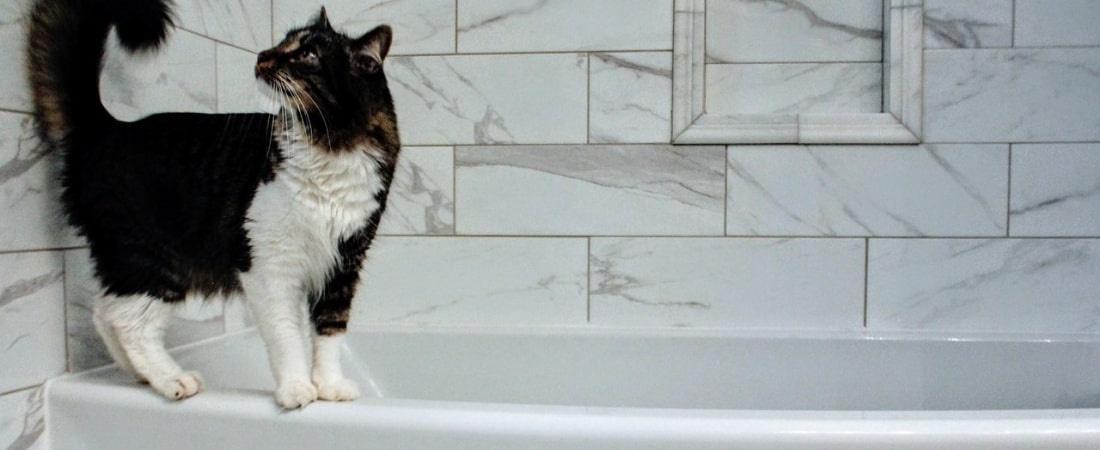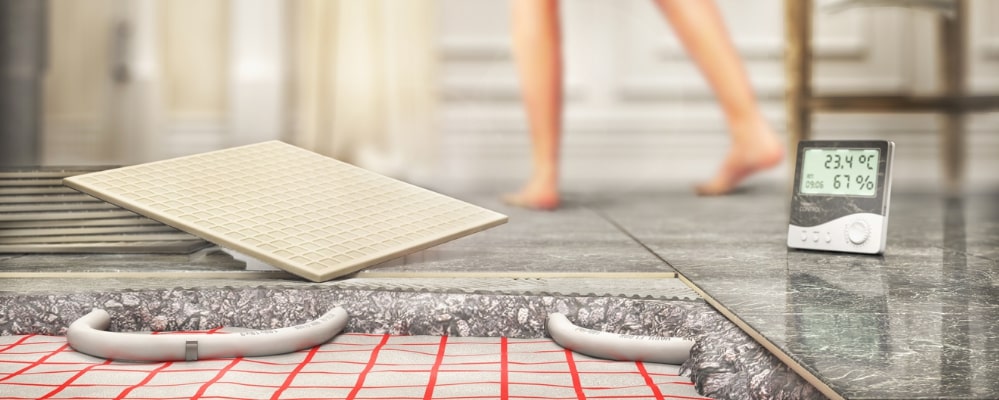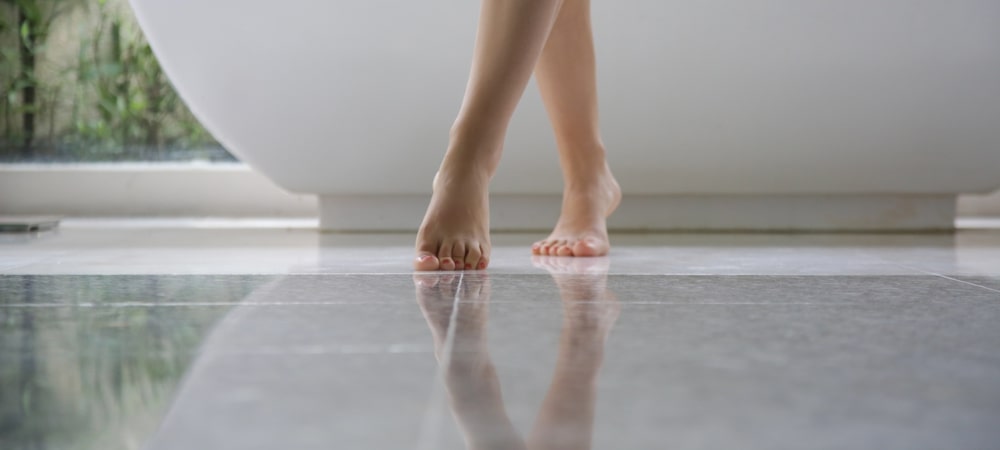That time of year is finally here. Facing the frosty morning temperatures and tip-toeing across icy bathroom tiles to jump in the shower is nothing short of agony.
You may think that Antarctic-level bathroom tiles are just a staple of the winter months. But, thankfully, there is a solution to rid you of this glacial curse: bathroom underfloor heating.
Heated floors are a luxury item that will completely transform your winter bathroom experience. Alongside creating a cosy space, this heater system also contributes to more efficient household heating.
Before deciding whether or not your bathroom could benefit from floor heating, let’s discuss the pros and cons of heated bathroom floors.
How Does Bathroom Floor Heating Work?
Just before we get into the nitty-gritty, let’s first understand what underfloor heating actually involves. Creating a heated bathroom floor requires a radiant source of heat to be installed underneath the tiles. This can either be via an electronic heating element or hydronic heating.
Electric Underfloor Heating
An electric heated floor, as the name suggests, uses electricity to generate heat. Electric cables are embedded within thin mats that are then installed beneath your bathroom floor tiling.
Between the two, electric underfloor heating is the easier option to install. This is why many homeowners go down the electric route when choosing an underfloor heating system.
The thin mats are connected to a thermostat controller, allowing you to easily set your ideal floor warmth. The heating process is fast, too. The desired temperature will be reached in just 30 – 60 minutes. And, when you’ve had enough warmth for the day, electric heated bathroom tiles can be easily switched off using the remote.
If electric underfloor heating systems sound right up your alley, just remember to be specific with sizing. Take into account any cabinets or fixtures occupying floor space. Full-sized electric heating mats are only effective in open plan areas, so you’ll have to be strategic with installation.
Hydronic Heating
Hydronic underfloor heating is very unique in its design. Also commonly referred to as hot water radiant systems, hydronic units heat your floor by passing hot water through tubes laid beneath your bathroom tiles.
The heating process starts within your home’s central boiler, which warms up the water until it reaches a set temperature. This water is then dispersed throughout piping coils that have been installed beneath a concrete slab in your floor. As concrete is a fantastic heat conductor, the warmth is evenly spread across the floor’s entire surface area.
Whilst hydronic heating is the perfect bathroom heater for a chilly July morning, it’s also a great heating option for the rest of your home. In fact, the wider the scope of this heating system within your home, the more cost-effective the installation.

Pros of Bathroom Underfloor Heating
Now that we’ve covered the basics of an underfloor heating system, we can now delve into the advantages and disadvantages of this choice. There are many benefits to floor heating, including:
Energy Efficient
In order to effectively heat an entire room, traditional radiators will typically need to be heated to around 65-75°C. On the other hand, underfloor heating only needs to be set to a temperature of 29°C or less, depending on the type of flooring finish in your bathroom.
This lower temperature output means that these systems use less energy to reach their optimal setting. Reduced energy consumption means significantly lower energy bills for the long term. And it can be operated with a programmable thermostat.
No Cold Spots
A huge benefit of underfloor systems is their uniform heating output. Traditional radiators can often disperse heat unevenly, meaning unpleasant cold spots are scattered throughout the room. Whilst the area directly in front of the unit or duct is warm, the rest of the room is neglected.
This isn’t an issue with heated floor systems. Both hydronic and electric underfloor heat provides even warmth across your entire floor space, which radiates up to cover the entire room without any stuffiness or cold spots.
Low Maintenance
Once your underfloor heating system is installed, the ongoing maintenance requirements are very minimal. Electric systems are pretty much ‘set and forget’ when it comes to regular care, however hydronic systems may need the occasional service to make sure everything continues working properly.
Space Freedom
Underfloor heating also means complete design freedom for your bathroom. Even modern radiators need to take up wall space, which can interfere with your overall bathroom aesthetic.
Underfloor heating is tucked away under your flooring, meaning it is entirely out of sight and out of mind. You’ll still have absolute freedom to decorate your bathroom as you wish, and won’t need to factor a bulky heating unit into the mix.
Household Safety
Another big benefit of floor heating systems is their safety. As their installation is completed underfloor, you won’t need to worry about hot surfaces or sharp edges that can potentially cause harm.
Radiant underfloor heating is also a lot better for your bathroom’s air quality. Traditional heaters can reduce oxygen levels, and can cause dust particles to circulate around the room. In contrast, underfloor heating will keep your bathroom air fresh and rich in oxygen.

Cons of Bathroom Underfloor Heating
There’s not a lot to detract from the positives of underfloor heating. In reality, installation and maintenance will be the biggest challenges you’ll encounter. Here’s why.
Extensive Installation Process
Installing underfloor heating in an existing build is a time-consuming process. The heating system has to be retrofitted, which means your flooring has to be removed.
As a result, your concrete slab will have to be dug up so there is space for the components of an underfloor heating system. Unfortunately, this invasive process is unavoidable and the costs will be increased compared to the installation of underfloor heating in a new build.
Effects on Floor Height
This is another disadvantage that affects existing builds. A common concern of installing underfloor heating in established bathrooms is the impact it may have on the floor height.
Hydronic systems will need a deeper installation technique than their electric counterparts. For this reason, they are usually recommended for new builds over existing homes. However, electric systems may increase your floor height too, and create minor tripping hazards.
Repairs
Although underfloor systems are very low maintenance overall, they may need occasional repairs. A qualified expert can use a thermal camera to locate the issue without much hassle.
However, if a problem is detected, they may need to get under your bathroom tiles before repairing the issue. This provides some additional concerns as you also have tiles to look after and not everyone may be content with seeing their flooring dug up again and again.
Is Bathroom Underfloor Heating Worth it?
Underfloor heating is an easy and effective way to keep your bathroom cosy. While they may come with a higher installation cost than some heating systems, their overall energy efficiency can deliver big savings on your heating bills in the long run.
If you’re planning a new build, hydronic bathroom heating is a great option. However, if you’re looking to renovate an existing build, electronic systems will likely be the way to go. With all things considered, the comfort and energy savings that underfloor heaters provide will undoubtedly add value to your home.
Please note: This information is provided for advice purposes only. Regulations differ from state to state, so please consult your local authorities or an industry professional before proceeding with any work. See our Terms & Conditions here.

